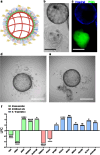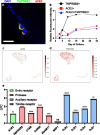This is a preprint.
Development of robust antiviral assays using relevant apical-out human airway organoids
- PMID: 38260306
- PMCID: PMC10802305
- DOI: 10.1101/2024.01.02.573939
Development of robust antiviral assays using relevant apical-out human airway organoids
Abstract
While breakthroughs with organoids have emerged as next-generation in vitro tools, standardization for drug discovery remains a challenge. This work introduces human airway organoids with reversed biopolarity (AORBs), cultured and analyzed in a high-throughput, single-organoid-per-well format, enabling milestones towards standardization. AORBs exhibit a spatio-temporally stable apical-out morphology, facilitating high-yield direct intact-organoid virus infection. Single-cell RNA sequencing and immunohistochemistry confirm the physiologically relevant recapitulation of differentiated human airway epithelia. The cellular tropism of five severe acute respiratory syndrome coronavirus 2 (SARS-CoV-2) strains along with host response differences between Delta, Washington, and Omicron variants, as observed in transcriptomic profiles, also suggest clinical relevance. Dose-response analysis of three well-studied SARS-CoV-2 antiviral compounds (remdesivir, bemnifosbuvir, and nirmatrelvir) demonstrates that AORBs efficiently predict human efficacy, comparable to gold-standard air-liquid interface cultures, but with higher throughput (~10-fold) and fewer cells (~100-fold). This combination of throughput and relevance allows AORBs to robustly detect false negative results in efficacy, preventing irretrievable loss of promising lead compounds. While this work leverages the SARS-CoV-2 study as a proof-of-concept application, the standardization capacity of AORB holds broader implications in line with regulatory efforts to push alternatives to animal studies.
Keywords: AT-511; Organoid; SARS-CoV-2; antiviral testing; apical-out; high-throughput; nirmatrelvir; remdesivir; standardization.
Conflict of interest statement
Competing Interests Lee, Parigoris, and Takayama are inventors on US20230194506A1, filed on May 21, 2021, related to this work.
Figures






Similar articles
-
The Human Nose Organoid Respiratory Virus Model: an Ex Vivo Human Challenge Model To Study Respiratory Syncytial Virus (RSV) and Severe Acute Respiratory Syndrome Coronavirus 2 (SARS-CoV-2) Pathogenesis and Evaluate Therapeutics.mBio. 2021 Feb 22;13(1):e0351121. doi: 10.1128/mbio.03511-21. Epub 2022 Feb 15. mBio. 2021. PMID: 35164569 Free PMC article.
-
Apical-Out Human Airway Organoids Modeling SARS-CoV-2 Infection.Viruses. 2023 May 14;15(5):1166. doi: 10.3390/v15051166. Viruses. 2023. PMID: 37243252 Free PMC article.
-
Human Nasal Organoids Model SARS-CoV-2 Upper Respiratory Infection and Recapitulate the Differential Infectivity of Emerging Variants.mBio. 2022 Aug 30;13(4):e0194422. doi: 10.1128/mbio.01944-22. Epub 2022 Aug 8. mBio. 2022. PMID: 35938726 Free PMC article.
-
Alternatives to animal models and their application in the discovery of species susceptibility to SARS-CoV-2 and other respiratory infectious pathogens: A review.Vet Pathol. 2022 Jul;59(4):565-577. doi: 10.1177/03009858211073678. Epub 2022 Feb 7. Vet Pathol. 2022. PMID: 35130766 Review.
-
Current status of antivirals and druggable targets of SARS CoV-2 and other human pathogenic coronaviruses.Drug Resist Updat. 2020 Dec;53:100721. doi: 10.1016/j.drup.2020.100721. Epub 2020 Aug 26. Drug Resist Updat. 2020. PMID: 33132205 Free PMC article. Review.
References
Publication types
Grants and funding
LinkOut - more resources
Full Text Sources
Molecular Biology Databases
Miscellaneous
